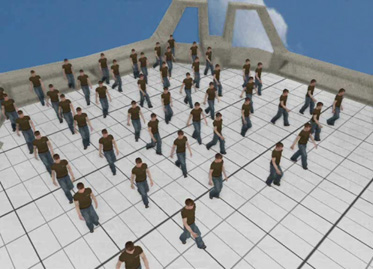Research Area
Neural and Computational Principles of Action and Social ProcessingResearchers
Albert Mukovskiy Martin A. Giese;Collaborators
Ae-Ni ParkDescription
 An important domain of the application of dynamical systems in computer animation is the simulation of autonomous and collective behavior of many characters, e.g. in crowd animation. Some work in this domain has been inspired by observations in biology showing that coordinated behavior of large groups of agents, such as flocks of birds, can be modeled at an emergent behavior that results from the dynamic interactions between individual agents, without requiring a central mechanism that ensures coordination. The dynamical stability properties of such systems have rarely been addressed due to the complexity of the underlying dynamics. This makes it interesting to develop methods for the design of the stability of such systems.
An important domain of the application of dynamical systems in computer animation is the simulation of autonomous and collective behavior of many characters, e.g. in crowd animation. Some work in this domain has been inspired by observations in biology showing that coordinated behavior of large groups of agents, such as flocks of birds, can be modeled at an emergent behavior that results from the dynamic interactions between individual agents, without requiring a central mechanism that ensures coordination. The dynamical stability properties of such systems have rarely been addressed due to the complexity of the underlying dynamics. This makes it interesting to develop methods for the design of the stability of such systems.
The goal of this project is to introduce a novel framework for the analysis and design of the stability properties of systems for interactive character animation. In collaboration with J.-J. E. Slotine (M.I.T.) we introduce Contraction Theory as new theoretical approach that permits a treatment of the dynamical properties of networks of coupled nonlinear dynamical elements. We analyze the stability conditions for the coordinated behavior of crowds, including synchronized walking, simultaneous navigation of the formation of ordered groups.
Demos:
